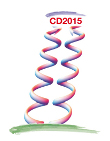Conveners
Parallel Session 4 - Hadron Structure & Meson-Baryon Interaction WG
- Patricia Solvignon (University of New Hampshire)
- Martin Hoferichter (TU Darmstadt)
- Andre Walker-Loud (College of William and Mary)
Johan Bijnens
(Lund University)
30/06/2015, 16:20
Hadron Structure and Meson-Baryon Interaction Working Group
Talk
The talk will give an overview of the work done recently in calculating leading logarithms to high order and the underlying methods used. The method used [1,2] will be done and an over view of applications which have been done to very high order in the massless case and up to seven loops in the massive case [3,4,5]. The talk will concentrate mainly on the new aspects needed for the nucleon...
Brian Tiburzi
(City College of New York)
30/06/2015, 16:50
Hadron Structure and Meson-Baryon Interaction Working Group
Talk
Techniques to compute hadron properties from lattice QCD rely upon the limit of long time separation. For baryons, the signal-to-noise problem often restricts one to time separations that are not ideally long, and for which couplings to excited states can obstruct the isolation of ground-state baryon properties. We consider excited-state contamination in nucleon two- and three-point...
Xiu-Lei Ren
(Beihang University/IPN Orsay)
30/06/2015, 17:10
Hadron Structure and Meson-Baryon Interaction Working Group
Talk
We report on a recent study of the ground-state octet baryon masses and sigma terms in the covariant baryon chiral perturbation theory (ChPT) with the extended-on-mass-shell (EOMS) renormalization scheme up to next-to-next-to-next-to-leading order (N3LO). To take into account lattice QCD artifacts, the finite-volume corrections (FVCs) and finite lattice spacing discretization effects are...
Jambul Gegelia
(Forschungszentrum Jülich)
30/06/2015, 17:30
Hadron Structure and Meson-Baryon Interaction Working Group
Talk
We suggest an extension of the one-nucleon sector of baryon chiral perturbation theory beyond the low-energy region. Applicability of the proposed approach for higher energies is restricted to small scattering angles, i.e. the kinematical region where the quark structure of hadrons cannot be resolved. The main idea is to re-arrange the low-energy effective Lagrangian according to a new power...
Bingwei Long
(Sichuan University, Chengdu)
30/06/2015, 17:50
Hadron Structure and Meson-Baryon Interaction Working Group
Talk
As the pion mass approaches a critical value m_pi^star, an S-wave baryon resonance can cross pion-baryon threshold, thus driving the scattering length to diverge. Charmed baryon resonance Lambda_c^+(2595) appears to be a realization of such a system. I explore the consequences of chiral symmetry for m_pi near m_pi^star, which are all centered around the finding that if m_pi^star is not too...
Rafel Escribano
(Autonomous University of Barcelona)
30/06/2015, 18:10
Goldstone Boson Working Group
Talk
In a combined study of the decay spectra of τ−→KSπ−ντ and τ−→K−ηντ decays within a dispersive representation of the required form factors, we illustrate how the K∗(1410) resonance parameters, defined through the pole position in the complex plane, can be extracted with improved precision as compared to previous studies. While we obtain a substantial improvement in the mass, the uncertainty in...

